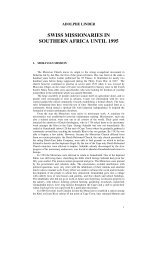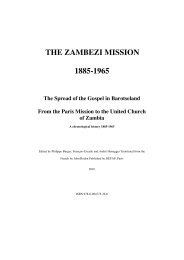THE SWISS IN SOUTHERN AFRICA 1652-1970 - swissroots-za.ch
THE SWISS IN SOUTHERN AFRICA 1652-1970 - swissroots-za.ch
THE SWISS IN SOUTHERN AFRICA 1652-1970 - swissroots-za.ch
Create successful ePaper yourself
Turn your PDF publications into a flip-book with our unique Google optimized e-Paper software.
amount should the Directors refuse to ratify the appointment. They refused and<br />
Bonstetten decided to relinquish his position and return to Europe, at the same time<br />
requesting a pension and a more distinguished titular rank without increase in pay. This<br />
too was refused, 2 but he was given permission to leave after the Governor had coerced<br />
his own son and Louis Thibault to stand surety for the repayments due by Bonstetten.<br />
Back in Switzerland Bonstetten joined the Swiss army as major and had the means to<br />
repay but defaulted, whi<strong>ch</strong> caused some finanial anxiety for Thibault. 3<br />
/ Meuron, Guy de: Le régiment Meuron, 1781-1816, p. 301 and KAB, MR 1788-1789; 2<br />
Leibbrandt: Requesten 1790: 70; 3 De Puyfontaine: Louis Mi<strong>ch</strong>el Thibault.<br />
A BRAVE SOLDIER AND MAN OF PROPERTY<br />
De la Harpe, Jean-Charles born Rolle VD, born 22.4.1751, died George 8.8.1839.<br />
De La Harpe was the Swiss with the most distinguished family background to settle at<br />
the Cape before 1800. From him all the De La Harpes in South Africa are descended.<br />
By coincidence Aubonne lies only about three kilometres from the birthplace of Jean<br />
Sublet who found happiness in a humble cottage in the mountains above Simon’s Town.<br />
Was Jean-Charles more successful?<br />
The De La Harpes have traced their family tree back to 1387 when one Pierre de Alpa<br />
& de Apa, Chambellan de Boppe and Régente de Savoie, became burgess of the town<br />
Thonon on the Fren<strong>ch</strong> shore of Lake Geneva. 1 Throughout the ages they have maintained<br />
their upper class status. Members of the family entered various professions and<br />
many distinguished themselves. Thus a Fren<strong>ch</strong>man passing through Cape Town in 1795<br />
referred to Jean-Charles as “the nephew of the academician de La Harpe” and a distant<br />
cousin, Frederic-Ceasar de La Harpe, was tutor of the young Alexander who later as<br />
Tsar of Russia defeated Napoleon’s army. Many embarked on military careers and<br />
indeed the officers’ roll of the Regiment Meuron lists three De La Harpes.<br />
La Harpe was 32 when he arrived here with the regiment in 1783. He soon married a<br />
local girl, Christina Mostert, by whom he had seven <strong>ch</strong>ildren. When the regiment was<br />
sent to Ceylon he was seriously ill and remained here, serving as Lieutenant-Captain at<br />
the regimental depot until his resignation in 1790, when he became a burgher of the<br />
Cape.<br />
As burgher he was required to join the burgher militia in whi<strong>ch</strong> he served as second in<br />
command of the cavalry. When the British invaded the Cape in 1795 he saw active<br />
service during whi<strong>ch</strong> his outstanding bravery was noted. The cavalry had strongly<br />
supported Colonel Henry’s plan to attack the British while they were consolidating their<br />
position in Muizenberg. When this was thwarted by orders from the Castle, they took<br />
independent offensive action wherever possible. During the British advance from<br />
Muizenberg towards Wynberg, the Burgher Cavalry although comprising only about<br />
200 horsemen, turned back to <strong>ch</strong>allenge them and opened a tremendous fire. But the<br />
British kept on advancing steadily in the open country and spread out, forcing the<br />
Burgher Cavalry to fall back. Jean-Charles seeing his banner retreating at full speed,<br />
snat<strong>ch</strong>ed it from the standard bearer as he was galloping past and planted it on a dune in<br />
the face of the British Colonel, urging his comrades to rally and halt the enemy’s<br />
advance. La Harpe was so close to the British that a shower of bullets came down<br />
around him. A British soldier leapt from amongst the bushes in order to fell him but de<br />
La Harpe’s horse, startled by the sudden appearance of the soldier, swerved and the shot<br />
went astray. 3<br />
During the second British invasion in 1806 La Harpe now 56 years old, was Captain-<br />
Lieutenant of the Burgher Cavalry. The account book for the war <strong>ch</strong>est records that he<br />
94







